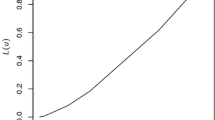Abstract
A relative invariant and an absolute invariant inequality ordering satisfying extreme bottom-sensitivity, are proposed. It is shown that the leximin social welfare ordering can be expressed in terms of a ranking of distributions on the sole basis of their size, measured by the mean, and the degree of inequality, measured according to these inequality concepts. Leximin thus exhibits extreme bottom-sensitivity. This property does not withstand that leximin prefers a larger size of the cake at the cost of higher inequality in a number of cases. These trade-offs between size and equality are characterised in terms of degrees of dominance of the lower parts of the ordinary and absolute Lorenz curves that are accepted by leximin for a given increase in the mean.
Similar content being viewed by others
References
Atkinson, A.B.: On the measurement of inequality. J. Econ. Theory 2, 244–263 (1970)
Blackorby, C., Donaldson, D.: Measures of relative inequality and their meaning in terms of social welfare. J. Econ. Theory 18, 59–80 (1978)
Blackorby, C., Donaldson, D.: A theoretical treatment of indices of absolute inequality. Int. Econ. Rev. 21, 107–136 (1980)
Blackorby, C., Donaldson, D.: Ethically significant ordinal index of relative inequality. In: Basmann, R., Rhodes, G. (eds.) Advances in Econometrics, vol. III, pp. 131–147. JAI Press (1984)
d’Aspremont, C., Gevers, L.: Equity and the informational basis of collective choice. Rev. Econ. Stud. 44, 199–209 (1977)
Bosmans, K.: Comparing degrees of inequality aversion. Soc. Choice Welf. 29, 405–428 (2007)
Bossert, W., Pfingsten, A.: Intermediate inequality: concepts, indices, and welfare implications. Math. Soc. Sci. 19, 117–134 (1990)
Debreu, G.: Representation of a preference ordering by a numerical function. In: Thrall, R.M., Coombs, C.H., Davis, R.L. (eds.) Decision Processes, pp. 59–65. Wiley, New-York (1954)
Donaldson, D., Weymark, J.: A single-parameter generalization of the Gini indices of inequality. J. Econ. Theory 22, 67–88 (1980)
Ebert, U.: Size and distribution as determinants of social welfare. J. Econ. Theory 41, 23–33 (1987)
Gevers, L.: On interpersonal comparability and social welfare orderings. Econometrica 47, 75–89 (1979)
Hammond P.J.: A note on extreme inequality aversion. J. Econ. Theory 11, 465–467 (1975)
Hammond, P.J.: Equity, Arrow’s conditions, and Rawls’ difference principle. Econometrica 44, 793–804 (1976)
Kolm, S.-Ch.: The optimal production of social justice. In: Margolis, J., Guitton, H. (eds.) Public Economics: An Analysis of Public Production and Consumption and Their Relations to the Private Sectors, pp. 145–200. MacMillan (1969)
Lambert, P.: The Distribution and Redistribution of Income, 3rd edn. Manchester University Press (2001)
Moyes, P.: A new concept of Lorenz domination. Econ. Lett. 23, 203–207 (1987)
Pollak, R.: Additive utility functions and linear Engel curves. Rev. Econ. Stud. 38, 401–414 (1971)
Sen, A.K.: Collective Choice and Welfare. Holden-Day (1970)
Sen, A.K.: On Economic Inequality. Oxford University Press (1973)
Sen, A.K.: On weights and measures: informational constraints in social welfare analysis. Econometrica 45, 1539–1572 (1977)
Shorrocks, A.F.: Ranking income distributions. Economica 50, 3–17 (1983)
Author information
Authors and Affiliations
Corresponding author
Rights and permissions
About this article
Cite this article
Capéau, B. Size and distribution trade-offs for the leximin ordering. J Econ Inequal 11, 237–248 (2013). https://doi.org/10.1007/s10888-012-9219-2
Received:
Accepted:
Published:
Issue Date:
DOI: https://doi.org/10.1007/s10888-012-9219-2




